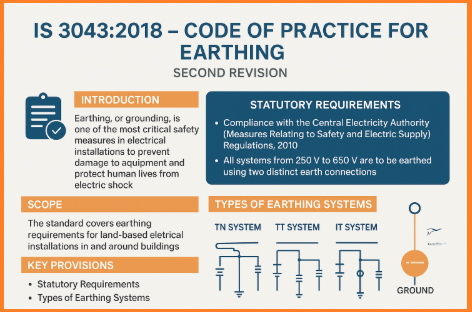Earthing, also known as grounding, is one of the most critical safety measures in electrical installations. It provides a path for fault currents to safely flow into the ground, preventing damage to equipment and safeguarding human lives from electric shock. To ensure uniformity and reliability in earthing practices, the Bureau of Indian Standards (BIS) has published IS 3043:2018 – Code of Practice for Earthing (Second Revision). This standard offers detailed guidelines for design, installation, testing, and maintenance of earthing systems across industries, substations, residential and commercial buildings.
Contents
Need for Earthing
The objectives of earthing are:
- To maintain exposed conductive parts of electrical equipment at earth potential to prevent electric shock hazards.
- To ensure fast and reliable operation of protective devices during earth faults.
- To prevent damage to equipment and fire hazards due to leakage or fault currents.
- To provide a stable reference potential for electrical systems.
Scope of IS 3043:2018
The standard covers earthing requirements for land-based electrical installations in and around buildings. It applies to:
- Protective earthing of low-voltage installations (equipment earthing).
- System earthing of low-voltage systems (neutral earthing).
- Generator earthing and switching arrangements.
It does not apply to ships, aircraft, offshore installations, or internal equipment earthing sensitive to static electricity.
Key Provisions of IS 3043:2018
1. Statutory Requirements
- Earthing must comply with the Central Electricity Authority (Measures Relating to Safety and Electric Supply) Regulations, 2010.
- All electrical systems from 250 V to 650 V must be earthed using two distinct earth connections.
- For HV and EHV systems, neutral points must be earthed at substations/generating stations using at least two electrodes.
2. Types of Earthing Systems
IS 3043:2018 adopts international classifications:
- TN System: Source neutral is earthed, and exposed parts are connected to the source earth through protective conductors. Variants: TN-S, TN-C, TN-C-S.
- TT System: Source neutral is earthed, but equipment is connected to a local earth electrode, independent of source earth.
- IT System: Source unearthed or earthed through high impedance; equipment connected to independent earth electrodes.
This classification helps in system selection for residential, commercial, and industrial applications.
3. Equipment Earthing
- Class I equipment (metallic enclosures) must be permanently connected to earth.
- Class II equipment (double insulated) may not require earthing.
- Earthing conductors should be of sufficient cross-sectional area to withstand fault current without overheating.
- Green-yellow bicolour is the only acceptable marking for protective conductors.
4. Resistance to Earth
- The resistance of an earthing system depends primarily on soil resistivity, moisture, and salt content.
- Ideal values:
- For large power stations: ≤ 0.5 Ω
- For small substations: ≤ 1.0 Ω
- For residential installations: ≤ 5 Ω
- Soil treatment with bentonite, salt, or charcoal can help reduce resistance.
- Seasonal variations in soil moisture must be considered during design.
5. Earth Electrodes
IS 3043:2018 specifies different types of electrodes:
- Pipe Electrodes – GI/CI pipe driven vertically into the ground.
- Plate Electrodes – GI/MS/Copper plates buried in earth pits.
- Strip or Wire Electrodes – Conductors buried horizontally.
- Earth Mats & Grids – Used in substations for equal potential distribution.
- Concrete Encased Electrodes – Use of conductive concrete for improved performance.
6. Safety in Earthing
- Proper earthing minimizes the risks of step voltage and touch voltage, which occur when a person’s body bridges potential differences during a fault.
- The standard provides permissible limits for human body current and duration to prevent fatal electric shocks.
- Equipotential bonding of metallic structures ensures uniform potential and prevents sparking hazards.
7. Earthing in Special Installations
- Power Stations & Substations: Grid earthing with equipotential bonding is mandatory.
- Overhead Power Lines: Poles, structures, and stay wires must be earthed.
- Medical Establishments: Special protective measures against leakage currents are prescribed.
- Mines & Quarries: Robust earthing required due to hazardous environments.
- Data Centers & IT Installations: Dedicated earthing for sensitive electronic equipment.
- Street Lighting & Furniture: Earthing of poles and metallic parts for public safety.
8. Testing & Maintenance
- Earth resistivity measurement: Wenner’s four-electrode method.
- Earth electrode resistance measurement: Fall-of-potential method.
- Loop impedance testing: Ensures protective devices operate correctly.
- All connections must be accessible for inspection.
- Earthing systems should be periodically tested, especially before monsoons.
Major Updates in 2018 Revision
Compared to IS 3043:1987, the 2018 revision includes:
- Removal of lightning protection (covered separately in IS/IEC 62305).
- Updated soil resistivity and enhancement techniques.
- Inclusion of concrete-encased electrodes.
- Guidelines for unearthed generators below 10 kW.
- Earthing for IT installations and data centers.
- Updated methods for soil resistivity and electrode resistance testing.
The IS 3043:2018 standard plays a crucial role in ensuring electrical safety and reliability in India. By laying down scientific guidelines for design, installation, and maintenance of earthing systems, it protects human life, equipment, and infrastructure from electrical hazards. Adhering to this code is not just a regulatory requirement but a fundamental step towards achieving safe and efficient electrical installations.





